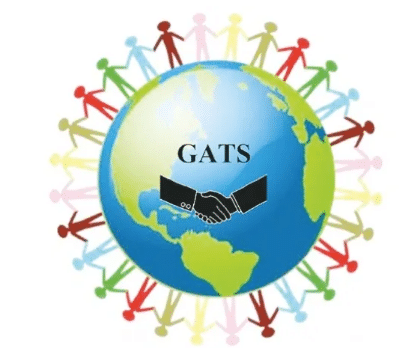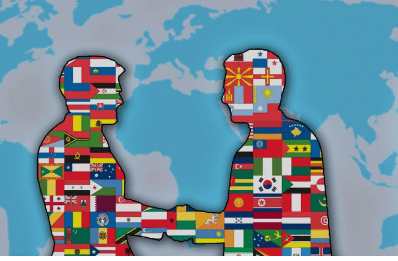GATS, TRIPS & TRIMS | Crash Course for UGC NET Commerce PDF Download
| Table of contents |

|
| What is GATS? |

|
| What is TRIPS? |

|
| What are Intellectual Property Rights? |

|
| What are Trade-Related Investment Measures (TRIMs)? |

|
| What is the TRIMs Agreement? |

|
What is GATS?

The General Agreement on Trade in Services (GATS) is a framework under the World Trade Organization (WTO) that sets rules for international trade in services. This includes sectors like banking, insurance, telecommunications, tourism, transportation, education, and healthcare. Before GATS, there were no multilateral regulations governing this expanding sector of the global economy.
Objectives of GATS
GATS aims to:
- Liberalize Trade in Services: Reduce barriers to make it easier for services and service providers to operate across borders.
- Promote Fair Competition: Ensure a level playing field by providing non-discriminatory market access and effective regulations.
- Achieve Higher Market Access: Negotiate commitments from countries to open up more sectors and ease restrictions through ongoing negotiation rounds.
- Increase Participation of Developing Nations: Support the integration of developing countries into the global services market, recognizing their unique challenges.
- Create Predictable Trading Conditions: Establish clear rules and principles to make the trading environment more stable and predictable.
- Promote Efficient Service Delivery: Enhance resource allocation and service production efficiency through liberalization and competition.
- Enhance Consumer Welfare: Provide consumers with access to a broader range of services at better prices and quality due to increased competition.
- Facilitate Technology and Knowledge Transfer: Promote the exchange of technology, expertise, and business practices, boosting productivity and development.
- Contribute to Economic Growth: Support overall economic growth by improving efficiency, competitiveness, and innovation across all sectors.
GATS in International Business
GATS impacts international business by:
- Reducing Restrictions: Lowering or eliminating limits on foreign participation, ownership, and operations in various service sectors.
- Improving Competition: Increasing market access drives businesses to enhance efficiency, innovation, and service quality.
- Creating Opportunities: Expanding international business opportunities by reducing barriers in previously closed markets.
- Increasing Sourcing Options: Broadening the pool of foreign suppliers and business partners by reducing restrictions.
Main Purpose of GATS
The primary goal of GATS is to liberalize international trade in services by:
- Reducing Barriers: Addressing restrictions on foreign ownership, professional movement, quotas, etc.
- Eliminating Discriminatory Policies: Ensuring that foreign services are not disadvantaged compared to domestic ones.
- Promoting Fair Competition: Guaranteeing equal treatment of foreign services and transparent policy-making.
- Introducing Predictable Rules: Creating a stable and secure trading environment through clear rules and commitments.
- Providing Dispute Resolution: Using the WTO's dispute settlement system to resolve conflicts and enforce GATS provisions.
Basic Obligations Under GATS
Key obligations include:
- National Treatment: Equal treatment for foreign and domestic services and suppliers without discrimination based on nationality.
- Most-Favored-Nation Treatment (MFN): No discrimination among trading partners; all WTO members must be treated as favorably as the most favored partner.
- Transparency: Publication of all relevant laws and regulations, and provision of information through established inquiry points.
- Domestic Regulation: Ensuring that regulations are objective, transparent, and not more restrictive than necessary.
- Recognition: Facilitating the recognition of foreign qualifications to ease the movement of professionals.
- Trade Facilitation: Promoting efficient market operations by streamlining and simplifying regulations.
- Dispute Settlement: Accepting the WTO's dispute resolution mechanism for adjudicating GATS-related disputes and ensuring compliance.
What is TRIPS?
 The Trade-Related Aspects of Intellectual Property Rights (TRIPS) Agreement, negotiated between 1989 and 1990 during the Uruguay Round of the General Agreement on Tariffs and Trade (GATT), is administered by the World Trade Organization (WTO). TRIPS sets minimum standards for various forms of intellectual property (IP) protection, including trademarks, copyrights, geographical indications, patents, industrial designs, layout designs for integrated circuits, and trade secrets. It applies to all WTO member states and establishes legal exceptions and constraints to balance IP rights with public health and economic development goals. The TRIPS Council is responsible for implementing and overseeing the agreement's operation, which is sometimes referred to as a "Berne and Paris-plus" agreement.
The Trade-Related Aspects of Intellectual Property Rights (TRIPS) Agreement, negotiated between 1989 and 1990 during the Uruguay Round of the General Agreement on Tariffs and Trade (GATT), is administered by the World Trade Organization (WTO). TRIPS sets minimum standards for various forms of intellectual property (IP) protection, including trademarks, copyrights, geographical indications, patents, industrial designs, layout designs for integrated circuits, and trade secrets. It applies to all WTO member states and establishes legal exceptions and constraints to balance IP rights with public health and economic development goals. The TRIPS Council is responsible for implementing and overseeing the agreement's operation, which is sometimes referred to as a "Berne and Paris-plus" agreement.
Objective of TRIPS
The TRIPS Agreement aims to:
- Eliminate Trade Distortions and Obstructions: Address trade barriers related to intellectual property.
- Encourage Effective Protection of IPRs: Ensure the protection of intellectual property rights (IPRs) is adequate and effective.
- Facilitate Legitimate Commerce: Ensure that enforcement measures and procedures do not hinder legitimate trade.
What are Intellectual Property Rights?
Intellectual property (IP) refers to intangible assets or non-physical creations. These rights grant individuals exclusive control over their creative works for a specified period.
Categories of Rights Protected Under TRIPS
The TRIPS Agreement protects the following categories of IP rights:
Copyright: Protects literary and artistic works, including computer programs. It allows authors, performers, and producers to control the commercial leasing of their works. Protection extends to films, sound recordings, and broadcasting organizations, with varying terms of protection (50 years for sound recordings and 20 years for broadcasting organizations).
Trademarks: Protects signs or combinations of marks that distinguish goods or services. This includes personal names, letters, numerals, figurative elements, and color combinations. Trademarks help identify goods based on their geographical origin, and members must provide legal means to prevent misleading uses of such indications.
Industrial Designs: Provides a 10-year protection period for industrial designs, allowing owners to prevent unauthorized manufacturing, selling, or importing of goods incorporating protected designs.
Patents: Grants protection for inventions (products or processes) in all fields of technology that are new, involve an inventive step, and are capable of industrial application. Patent protection lasts for 20 years, with patent owners having the right to assign or transfer patents and enter into licensing contracts.
Integrated Circuits: Protects the layout designs of integrated circuits for 10 years, with protection expiring 15 years after the creation of the layout design.
Trade Secrets: Secures commercially valuable trade secrets from breaches of confidence and other activities. It also protects data submitted to governments for marketing approval of pharmaceuticals or agricultural chemicals from commercial exploitation.
Benefits of TRIPS
The TRIPS Agreement helps reduce trade conflicts over IP issues while allowing WTO members to pursue various domestic policies. The concept of trade has evolved beyond mere cross-border exchange, now encompassing the broader benefits to society from knowledge and creativity.
TRIPS in Times of COVID-19
In response to the COVID-19 pandemic, India and South Africa proposed in October 2020 that the TRIPS Agreement be waived for COVID vaccines, medicines, and diagnostics to make them more widely available. The proposal aimed to ensure that these critical health products reached as many people as possible during the pandemic.
Arguments in Favor of Loosening TRIPS Restrictions:
- Increased Accessibility: Loosening restrictions would make vaccines more accessible to people in developing countries and least developed countries (LDCs).
- Ethical Considerations: Everyone should have access to life-saving treatments, and pharmaceutical companies should not prioritize profit over public health.
- Global Safety: No one is safe until everyone is safe; it is crucial to ensure vaccines are available worldwide to prevent the spread of the virus.
Arguments Against the TRIPS Waiver:
- Innovation Incentives: Without compensation for their innovations, companies may not be able to recover research and development costs, reducing the incentive to innovate.
- Production Capabilities: Critics argue that small businesses in poorer countries may lack the capacity to mass-produce vaccines and medicines.
What are Trade-Related Investment Measures (TRIMs)?

Trade-Related Investment Measures (TRIMs) are regulations that govern how a country manages foreign investments through domestic policies. These measures were established as part of an industrial policy to facilitate the operations of international firms in foreign markets. TRIMs were negotiated under the General Agreement on Tariffs and Trade (GATT) and came into effect in 1995 as part of the World Trade Organization (WTO). TRIMs are one of the four key legal agreements within the WTO trade treaty.
History of TRIMs
In the late 1980s, foreign direct investment (FDI) saw a significant increase globally. In response, some countries imposed restrictions to protect their domestic industries and prevent the outflow of foreign exchange reserves. These restrictions included requirements related to local content, manufacturing, trade balancing, domestic sales, technology transfer, export performance, local equity, foreign exchange remittance, licensing, and employment. Such measures were found to violate GATT Articles III and XI, leading to their prohibition. Before the TRIMs Agreement, international agreements offering guidance on measures restricting foreign investment were limited in scope and content. The TRIMs Agreement was finalized during the Uruguay Round negotiations.
Objectives of TRIMs
The primary goal of TRIMs is to ensure that investment policies and regulations do not create unnecessary barriers to trade and to promote and facilitate the flow of foreign direct investment (FDI). Some key objectives include:
- Ensuring that foreign investors receive treatment no less favorable than domestic investors in terms of laws, regulations, and other investment-related measures.
- Preventing WTO members from using TRIMs to create unnecessary trade barriers or distort competition between domestic and foreign firms.
- Requiring WTO members to publish and provide information on their laws and regulations affecting investment, along with timely notification of any changes.
- Prohibiting investment measures that are inconsistent with or nullify the benefits of GATT 1994 for WTO members.
- Encouraging and facilitating investment by providing a stable, predictable, and transparent environment for investors.
- Allowing WTO members to take measures to safeguard their balance of payments, subject to specific conditions and limitations.
Overall, the TRIMs Agreement seeks to promote non-discriminatory investment policies and reduce unnecessary trade barriers related to investment measures.
Important Features of Trade-Related Investment Measures
TRIMs allow countries to implement laws and policies to regulate foreign investment within their borders. Key features include:
Local Content Requirements: These compel foreign investors to use local labor, equipment, or source a specific percentage of supplies or inputs locally. This supports domestic sectors, generates employment, and strengthens local supply chains.
Restrictions on Investment: Some countries may limit foreign investment in certain sectors or industries or require foreign investors to partner with domestic businesses. These limitations can protect domestic businesses and ensure local ownership and control.
Performance Requirements: These are criteria foreign investors must meet to qualify for specific benefits, such as tax reductions or market access. Examples include obligations to transfer technology to local partners or export a certain percentage of production. These requirements encourage technology transfer and regional economic growth.
Export Restrictions: Some countries may require foreign investors to export a specific proportion of their finished goods to promote exports and maintain a trade balance.
Licensing Requirements: Foreign investors may be required to obtain a license to operate in certain industries or comply with specific regulatory standards, ensuring that foreign investment aligns with national priorities and laws.
What is the TRIMs Agreement?
The TRIMs Agreement is a component of the WTO trade treaty that establishes rules to regulate the domestic regulations countries impose on foreign investors. The agreement aims to prevent measures that favor domestic firms over international ones, thereby facilitating the operations of foreign businesses in global markets. Negotiated under GATT, the TRIMs Agreement became effective in 1995.
Restrictions According to the TRIMs Agreement
The TRIMs Agreement prohibits measures deemed discriminatory toward foreign investors and trade-distorting, including:
Local Content Requirements: Prohibits measures requiring foreign investors to purchase local inputs or include a specific percentage of local content in their products.
Trade Balancing Requirements: Bans requirements that balance imports with exports or mandate foreign investments to achieve a certain level of domestic output or sales.
Export Performance Requirements: Prevents requiring foreign investors to export a specific percentage of their production or earn a certain amount of foreign currency from exports.
Domestic Sales Requirements: Restricts requirements that mandate foreign investors to sell a specific proportion of their goods in the domestic market.
However, the TRIMs Agreement allows WTO members to implement measures that encourage investment and do not discriminate against international investors, such as:
Efforts to Increase Efficiency: Measures aimed at enhancing the effectiveness of manufacturing and distribution.
Public Safety, Health, and Morality: Steps taken to protect these aspects within the country.
Support for SMEs: Efforts to promote the growth of small and medium-sized enterprises.
Conclusion
The Agreement on Trade-Related Investment Measures (TRIMs) is a vital component of the WTO that regulates investment measures impacting trade in goods and services. While it has faced criticism for potentially affecting domestic rules and regulations, it has undeniably contributed to a more open and transparent global trading system. Overall, the TRIMs Agreement is an essential tool for fostering a fair and competitive environment for global trade and investment.
|
157 videos|236 docs|166 tests
|
FAQs on GATS, TRIPS & TRIMS - Crash Course for UGC NET Commerce
| 1. What is GATS? |  |
| 2. What is TRIPS? |  |
| 3. What are Intellectual Property Rights? |  |
| 4. What are Trade-Related Investment Measures (TRIMs)? |  |
| 5. What is the TRIMs Agreement? |  |















